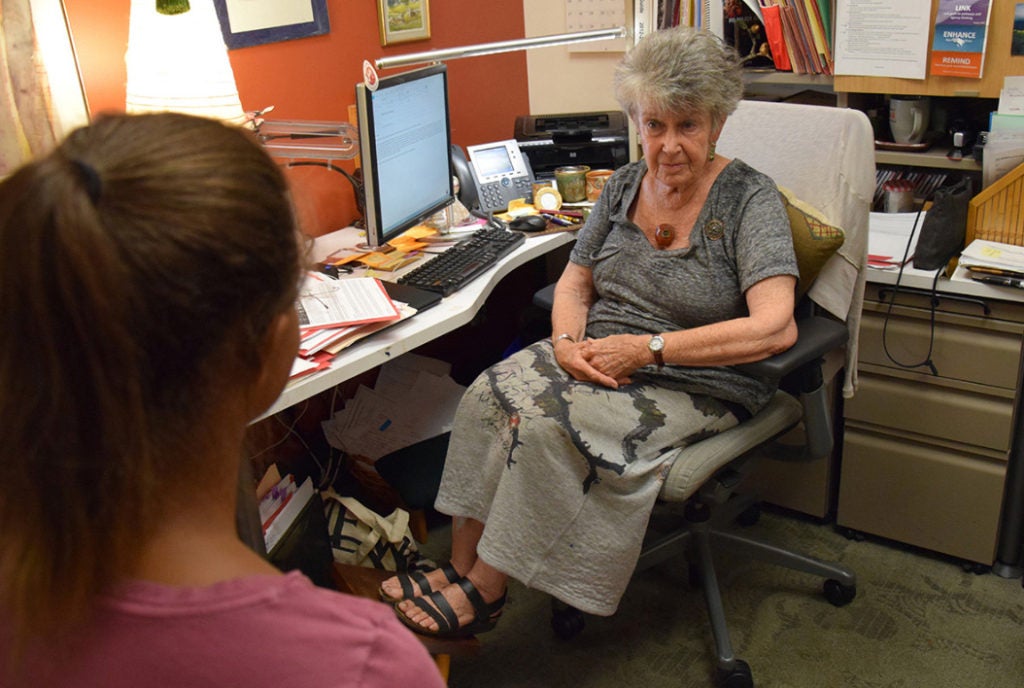Stanford building bridges between first-year students and academic advisers
Louis Newman, director of Undergraduate Advising and Research, talks about how advisers help guide the intellectual journeys of Stanford’s first-year students and transfer students.
What roles do academic advisers play in the lives of students?
They help students navigate the choices they have at Stanford, serving as a liaison, if you will, between the students and the faculty and the academic requirements of the university. They also serve as sounding boards to help students talk through some of the larger questions about their academic trajectory. Ideally, they help students take a step back and ask broader questions. What am I getting out of my education? Why am I choosing what I’m choosing? Am I making the best use of these four years in my life? What am I doing to broaden my horizons or to think outside the box?
What kinds of academic advising does Stanford provide to new students?
Each new student is assigned to one of our 12 full-time, academic advising directors, whose offices are in student residence halls. By working in the dorm, academic advising directors – most of whom have PhDs – become a visible part of the community, available for formal and spontaneous conversations about academic life.
They understand academic life and know Stanford’s general education requirements, as well as the required courses for majors and interdisciplinary programs. They help students choose among the wealth of opportunities available at Stanford, and help them deal with registration issues and navigate the university’s academic rules and procedures.
Academic advising directors also partner with Residential Education staff – resident fellows, residence deans and resident assistants – to offer programs that connect new students with resources and opportunities, as well as to support students who may be struggling as they make the transition to college life.
We also have five professional advisers who work with student-athletes in the Athletic Academic Resource Center (AARC) in the Arrillaga Center for Sports and Recreation. They are dedicated to the specialized needs of Stanford’s 900 student-athletes, including 225 first-year students who are athletes. They are former Division I athletes who understand the challenges students face balancing academic work and intensive practice schedules, as well as the eligibility requirements of the National Collegiate Athletic Association.
Every new student is assigned to a pre-major adviser. This program draws on the talents and dedication of about 500 faculty and staff members who volunteer their time. They meet regularly with students – at least once a quarter – until the students declare majors.
Once the school year begins, new students can visit the specialized advising team in Sweet Hall, where advisers are available during drop-in hours and by appointment. In addition to assisting any student who walks in the door, these professional advisers help students who are considering future careers in medicine and law. They also advise transfer students, including military veterans, and students who are interested in co-terminal degree programs, which allow students to simultaneously earn a bachelor’s and a master’s degree.
How do advisers help first-year students make the transition from high school?
All Stanford students are exceptionally talented in all kinds of ways. They are accustomed to being the best in at least one thing in high school; typically, they have excelled in many areas. At Stanford, they’re surrounded by hundreds of other students who are as talented as they are. They wonder if they’re in over their heads. They get their first “B” and don’t know what to make of that. Many think, “I am failing; I don’t belong here,” rather than “college is a lot harder than high school and it may take some time to adapt to the higher expectations of my professors.” That’s the point at which an adviser can talk them through the situation and help them contextualize the struggles they’re facing in this very high-achieving environment. That’s particularly true for first-year students who are trying to figure out what they’re good at and what they want to pursue.
Advisers also help students manage their newfound freedom to choose among many academic opportunities. Students are adjusting to a new world – socially, intellectually, personally – and the advising program at Stanford is designed to help them make that transition as smoothly and successfully as they can, recognizing that bumps in the road may be inevitable and may even lead to personal growth.
What role do pre-major advisers play in the lives of new students?
The best word to describe their role is “coach.” They are not expected to provide formal academic advice, but they do help new students connect with campus resources, and make sure that they are adjusting well to college life. They offer wisdom, guidance and support from the first day students arrive on campus. They are there to ask questions. What are you most excited about this term? What do you most need to succeed at Stanford? What are you most concerned or confused about and how can I help you address those issues? Pre-major advisers take part in an orientation program at the start of the school year.
Students are carefully matched with their pre-major advisers over the summer, based on information they share about their interests and what they’re looking for in an adviser. Students meet their pre-major advisers for the first time during New Student Orientation, which takes place the week before classes begin.
What are some of the challenges of advising first-year students?
Stanford students are a very diverse group. Approximately 17 percent of incoming students are first-generation college students, about 11 percent are international students, and about 12 percent are athletes who have strong commitments to their sport. (Of course, some of these categories overlap.) Each of those groups may have special concerns, needs or issues. Their backgrounds will influence the way they think about their education and the comfort level they have accessing the resources available to them. Advisers are trained to help students address the unique challenges they may face.
Sometimes, academic advisers need to help students understand how Stanford “works.” How do you walk into a faculty member’s office during office hours and ask about something you’re struggling with? What is a syllabus? What is it like to do research with a faculty member and what are the benefits of exploring those opportunities? These are not things that come naturally to all students.


